Analysing Organisational Behaviour: A Report on Primark's Practices
VerifiedAdded on 2023/01/13
|14
|4852
|100
Report
AI Summary
This report delves into the realm of organisational behaviour, using Primark as a case study to explore the interplay of culture, power, and politics on employee behaviour. It examines how organisational culture, including power dynamics (reward, expert), and political interactions shape individual actions within the workplace. The report further evaluates content and process theories of motivation, particularly the Expectancy Theory and Maslow's Hierarchy of Needs, to understand how these concepts influence employee performance. Finally, it contrasts the characteristics of effective and ineffective teams, providing a comprehensive analysis of the factors that contribute to successful team dynamics and overall organisational success. The report highlights the practical application of these theories within the retail environment of Primark, offering valuable insights into employee management and organisational effectiveness.
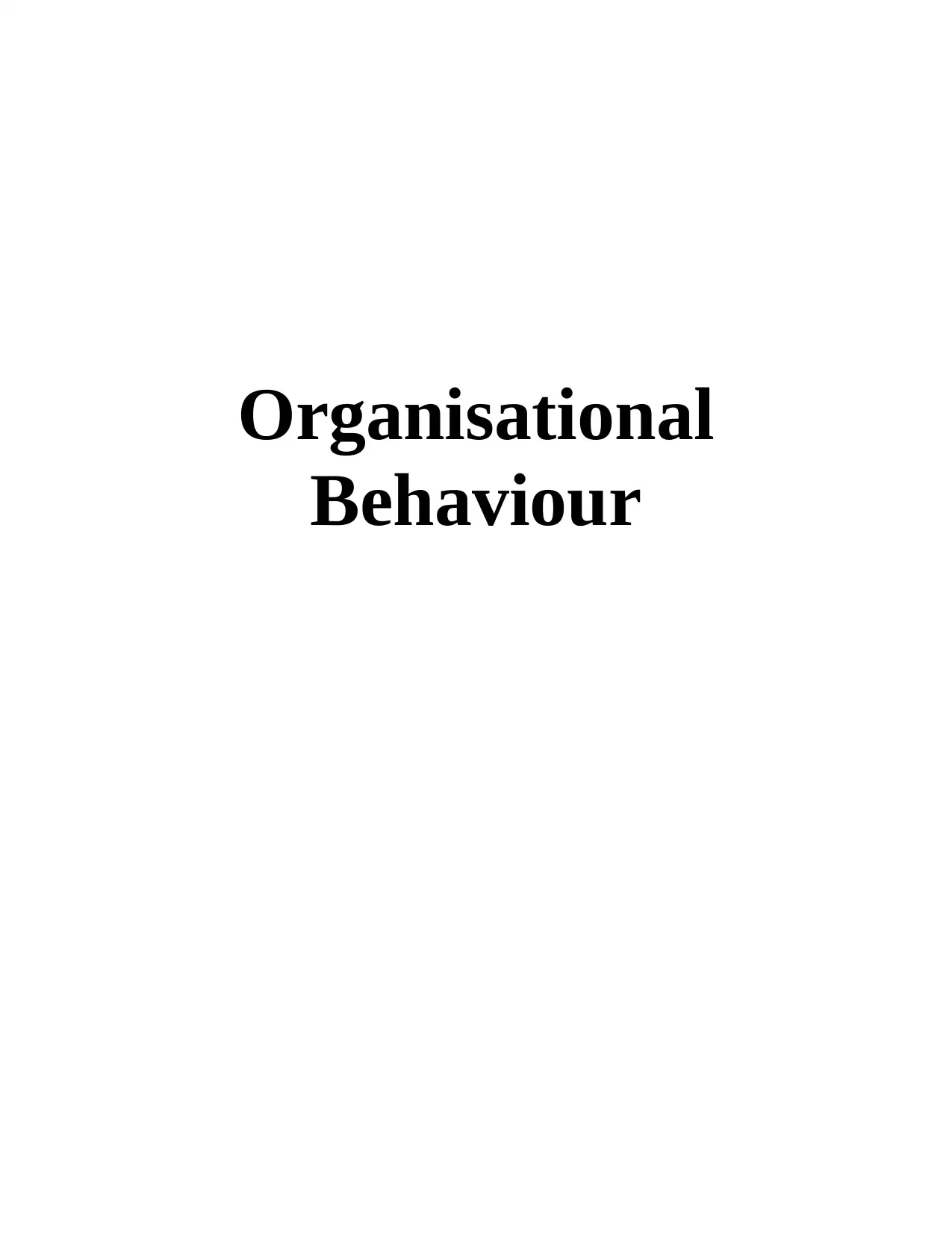
Organisational
Behaviour
Behaviour
Paraphrase This Document
Need a fresh take? Get an instant paraphrase of this document with our AI Paraphraser
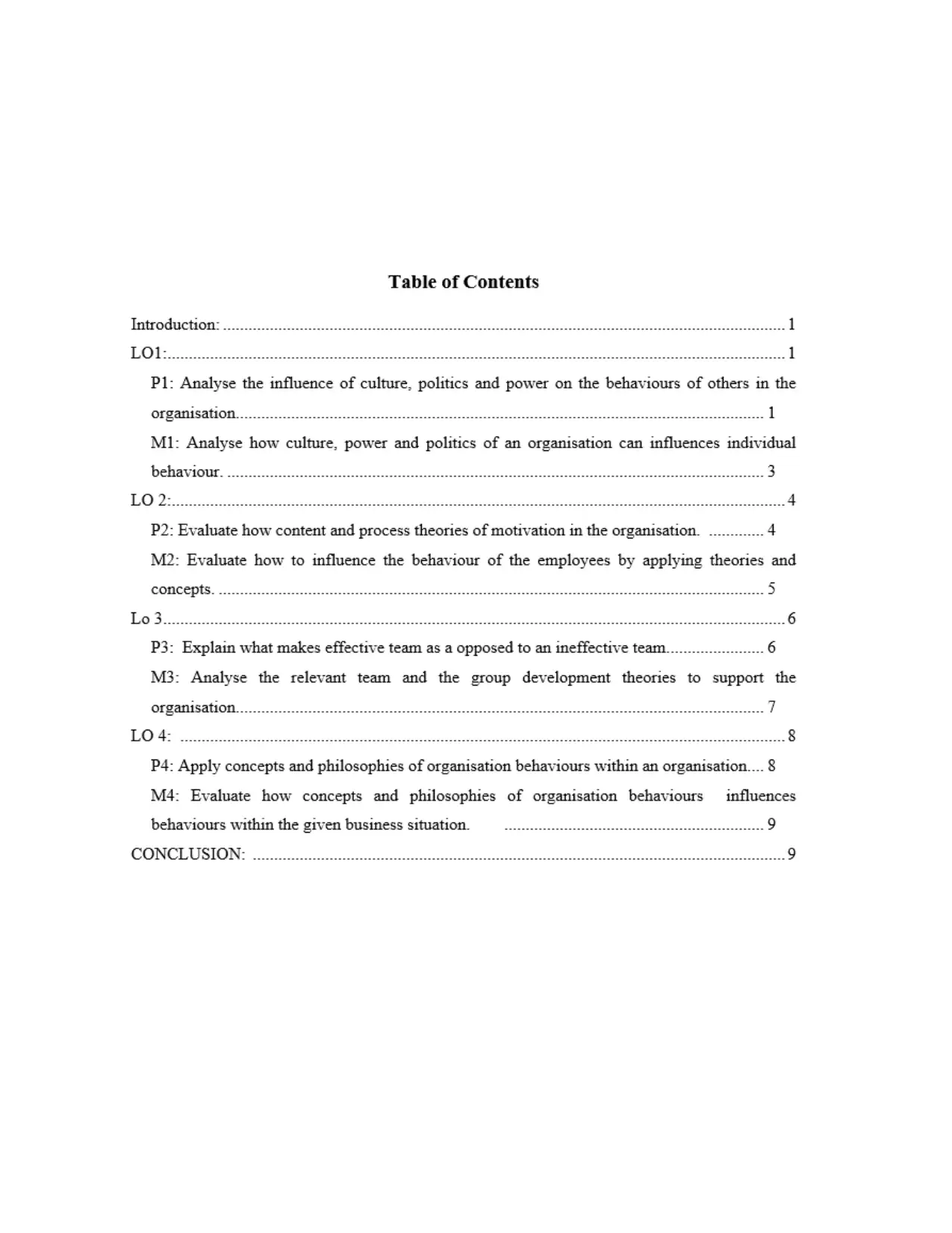
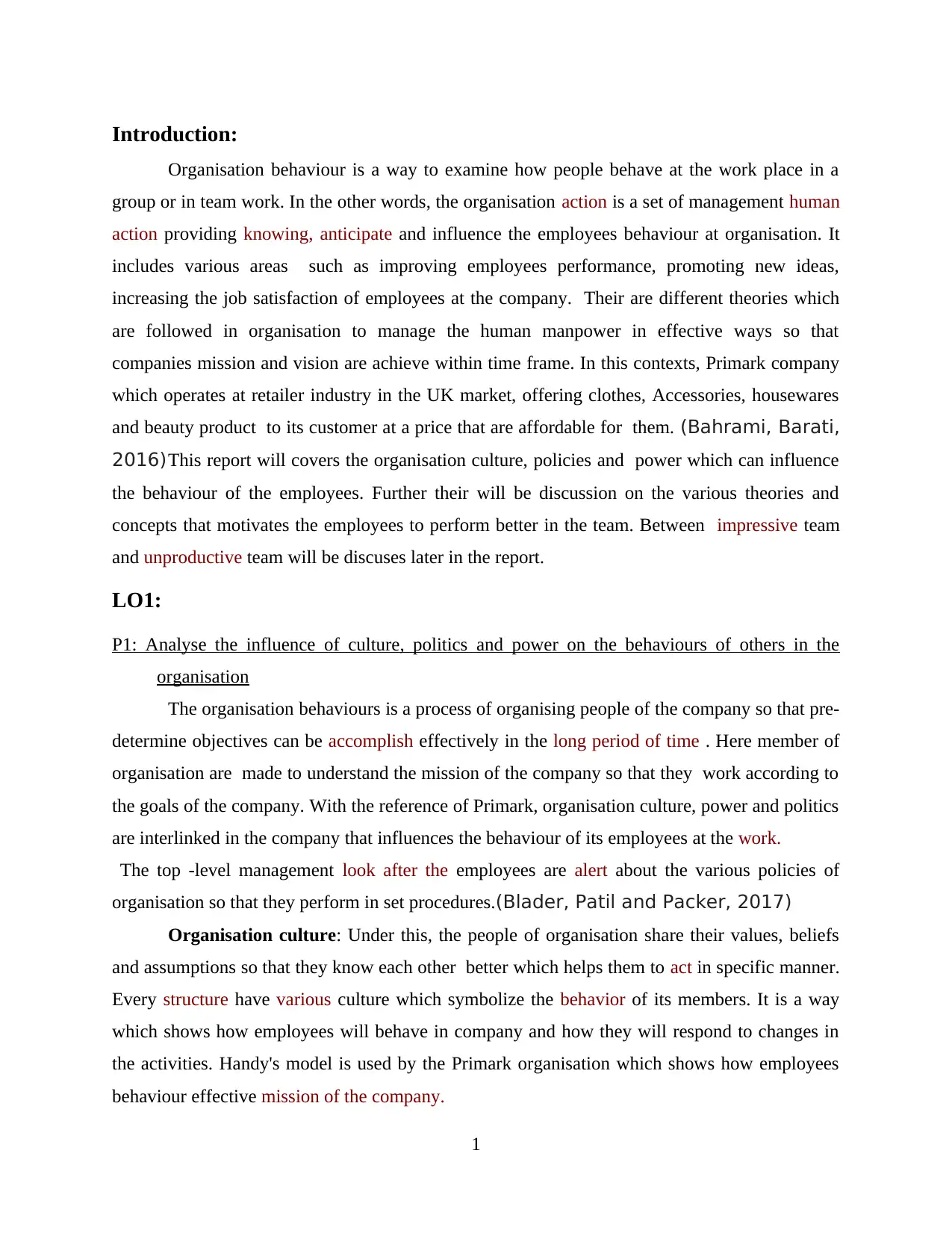
Introduction:
Organisation behaviour is a way to examine how people behave at the work place in a
group or in team work. In the other words, the organisation action is a set of management human
action providing knowing, anticipate and influence the employees behaviour at organisation. It
includes various areas such as improving employees performance, promoting new ideas,
increasing the job satisfaction of employees at the company. Their are different theories which
are followed in organisation to manage the human manpower in effective ways so that
companies mission and vision are achieve within time frame. In this contexts, Primark company
which operates at retailer industry in the UK market, offering clothes, Accessories, housewares
and beauty product to its customer at a price that are affordable for them. (Bahrami, Barati,
2016)This report will covers the organisation culture, policies and power which can influence
the behaviour of the employees. Further their will be discussion on the various theories and
concepts that motivates the employees to perform better in the team. Between impressive team
and unproductive team will be discuses later in the report.
LO1:
P1: Analyse the influence of culture, politics and power on the behaviours of others in the
organisation
The organisation behaviours is a process of organising people of the company so that pre-
determine objectives can be accomplish effectively in the long period of time . Here member of
organisation are made to understand the mission of the company so that they work according to
the goals of the company. With the reference of Primark, organisation culture, power and politics
are interlinked in the company that influences the behaviour of its employees at the work.
The top -level management look after the employees are alert about the various policies of
organisation so that they perform in set procedures.(Blader, Patil and Packer, 2017)
Organisation culture: Under this, the people of organisation share their values, beliefs
and assumptions so that they know each other better which helps them to act in specific manner.
Every structure have various culture which symbolize the behavior of its members. It is a way
which shows how employees will behave in company and how they will respond to changes in
the activities. Handy's model is used by the Primark organisation which shows how employees
behaviour effective mission of the company.
1
Organisation behaviour is a way to examine how people behave at the work place in a
group or in team work. In the other words, the organisation action is a set of management human
action providing knowing, anticipate and influence the employees behaviour at organisation. It
includes various areas such as improving employees performance, promoting new ideas,
increasing the job satisfaction of employees at the company. Their are different theories which
are followed in organisation to manage the human manpower in effective ways so that
companies mission and vision are achieve within time frame. In this contexts, Primark company
which operates at retailer industry in the UK market, offering clothes, Accessories, housewares
and beauty product to its customer at a price that are affordable for them. (Bahrami, Barati,
2016)This report will covers the organisation culture, policies and power which can influence
the behaviour of the employees. Further their will be discussion on the various theories and
concepts that motivates the employees to perform better in the team. Between impressive team
and unproductive team will be discuses later in the report.
LO1:
P1: Analyse the influence of culture, politics and power on the behaviours of others in the
organisation
The organisation behaviours is a process of organising people of the company so that pre-
determine objectives can be accomplish effectively in the long period of time . Here member of
organisation are made to understand the mission of the company so that they work according to
the goals of the company. With the reference of Primark, organisation culture, power and politics
are interlinked in the company that influences the behaviour of its employees at the work.
The top -level management look after the employees are alert about the various policies of
organisation so that they perform in set procedures.(Blader, Patil and Packer, 2017)
Organisation culture: Under this, the people of organisation share their values, beliefs
and assumptions so that they know each other better which helps them to act in specific manner.
Every structure have various culture which symbolize the behavior of its members. It is a way
which shows how employees will behave in company and how they will respond to changes in
the activities. Handy's model is used by the Primark organisation which shows how employees
behaviour effective mission of the company.
1
⊘ This is a preview!⊘
Do you want full access?
Subscribe today to unlock all pages.

Trusted by 1+ million students worldwide

Power culture:Every organisation have some special people who holds the power to
make sound business decision-making in the management. These people further divides the roles
and responsibilities to its another member of a team so that project is accomplished on time and
in effective way. The HR manager of Primark, follow this culture so that proper hierarchy is
followed in the team. employees have to precede the what their superior tells them to as there are
nor free to express their point of view in the team.(Bolino, Hsiung, Harvey 2015)
Task culture: Under this culture, unit is formed to dissolve the critical issues in
the systematic manner so that task is completed without any interference. Here few number of
employees are grouped together who will perform activities so that objectives attained in the
long run. Teams are formed who have a similar skills and knowledge and work is assigned to
them accordingly. The manager of Primark make use this culture so that task is completed in
positive way.
Person culture: Here employees are more concerned about themselves instead of the
goals of organisation. They have a point of view that individual is important then their
organisation. The company who uses this culture have to negative impact on the execution of the
company as individual goals are achieved instead of organisation. The Impact of this culture in
the Primark is negative as companies goals are ignored.
Role culture: here this culture, employees are give different duty and obligation
according to their skills and knowledge. Here employees are more focus on giving their best in
the given task so that targets can be achieved in time. The HR manger of Primark make best use
of such culture as employees are more competent in performing the tasks and some power is
provided to them to complete the task.(Borkowski, 2016.)
According to above discussion, it is stated that organisation culture, power and policies
have powerfulness on the behaviour of employees of the Primark company. The most suitable
culture is task for the Primark as it bring the effective timing among the employees. This
provide positive environment at the workplace.
Organisation power: Under this ,power give a proper way to manager as well as to the
employees to complete the given task. The different level of power in the organisation
influences the behaviours the employees that affects the outcome of the activities. Some of the
power are discussed as follows:
2
make sound business decision-making in the management. These people further divides the roles
and responsibilities to its another member of a team so that project is accomplished on time and
in effective way. The HR manager of Primark, follow this culture so that proper hierarchy is
followed in the team. employees have to precede the what their superior tells them to as there are
nor free to express their point of view in the team.(Bolino, Hsiung, Harvey 2015)
Task culture: Under this culture, unit is formed to dissolve the critical issues in
the systematic manner so that task is completed without any interference. Here few number of
employees are grouped together who will perform activities so that objectives attained in the
long run. Teams are formed who have a similar skills and knowledge and work is assigned to
them accordingly. The manager of Primark make use this culture so that task is completed in
positive way.
Person culture: Here employees are more concerned about themselves instead of the
goals of organisation. They have a point of view that individual is important then their
organisation. The company who uses this culture have to negative impact on the execution of the
company as individual goals are achieved instead of organisation. The Impact of this culture in
the Primark is negative as companies goals are ignored.
Role culture: here this culture, employees are give different duty and obligation
according to their skills and knowledge. Here employees are more focus on giving their best in
the given task so that targets can be achieved in time. The HR manger of Primark make best use
of such culture as employees are more competent in performing the tasks and some power is
provided to them to complete the task.(Borkowski, 2016.)
According to above discussion, it is stated that organisation culture, power and policies
have powerfulness on the behaviour of employees of the Primark company. The most suitable
culture is task for the Primark as it bring the effective timing among the employees. This
provide positive environment at the workplace.
Organisation power: Under this ,power give a proper way to manager as well as to the
employees to complete the given task. The different level of power in the organisation
influences the behaviours the employees that affects the outcome of the activities. Some of the
power are discussed as follows:
2
Paraphrase This Document
Need a fresh take? Get an instant paraphrase of this document with our AI Paraphraser
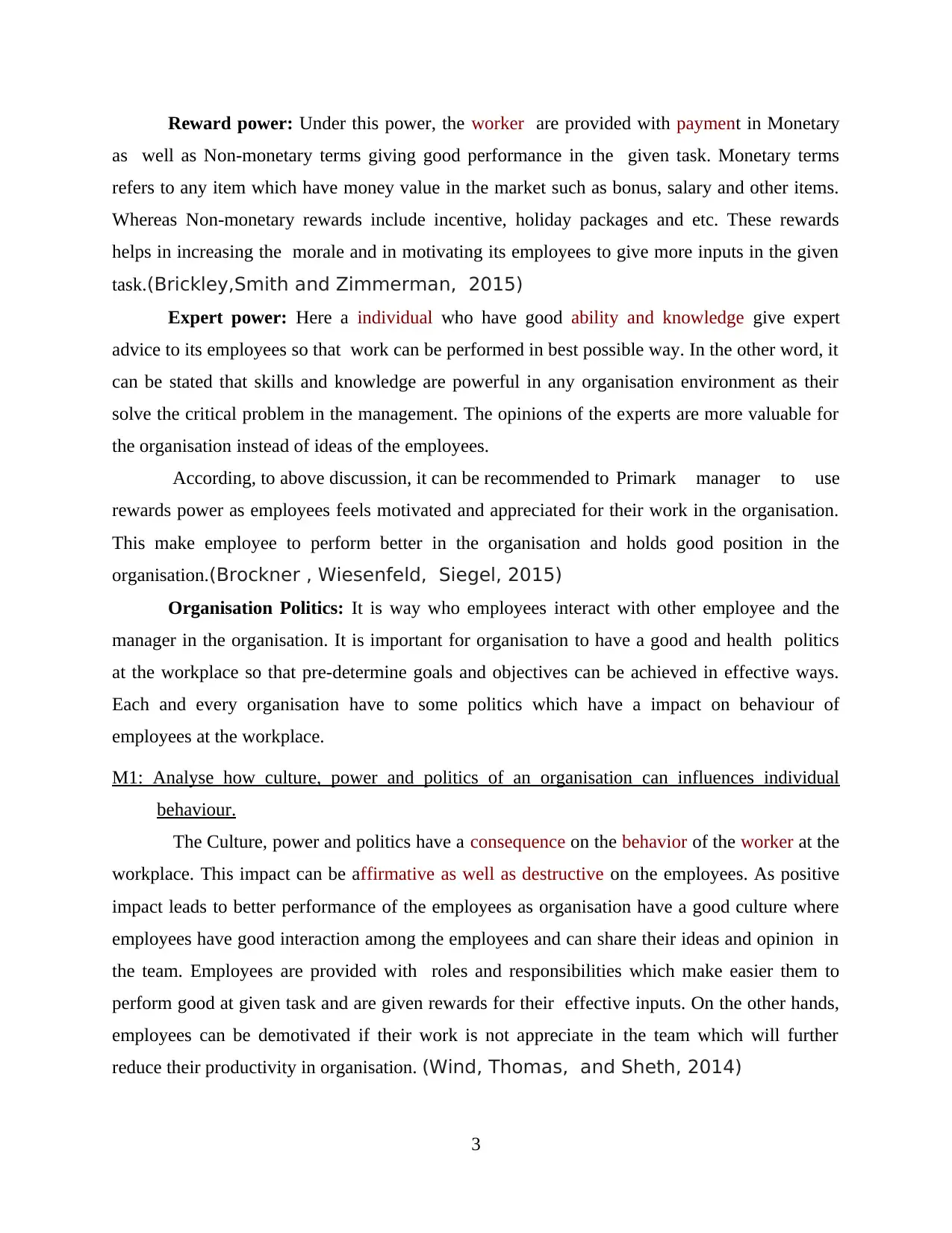
Reward power: Under this power, the worker are provided with payment in Monetary
as well as Non-monetary terms giving good performance in the given task. Monetary terms
refers to any item which have money value in the market such as bonus, salary and other items.
Whereas Non-monetary rewards include incentive, holiday packages and etc. These rewards
helps in increasing the morale and in motivating its employees to give more inputs in the given
task.(Brickley,Smith and Zimmerman, 2015)
Expert power: Here a individual who have good ability and knowledge give expert
advice to its employees so that work can be performed in best possible way. In the other word, it
can be stated that skills and knowledge are powerful in any organisation environment as their
solve the critical problem in the management. The opinions of the experts are more valuable for
the organisation instead of ideas of the employees.
According, to above discussion, it can be recommended to Primark manager to use
rewards power as employees feels motivated and appreciated for their work in the organisation.
This make employee to perform better in the organisation and holds good position in the
organisation.(Brockner , Wiesenfeld, Siegel, 2015)
Organisation Politics: It is way who employees interact with other employee and the
manager in the organisation. It is important for organisation to have a good and health politics
at the workplace so that pre-determine goals and objectives can be achieved in effective ways.
Each and every organisation have to some politics which have a impact on behaviour of
employees at the workplace.
M1: Analyse how culture, power and politics of an organisation can influences individual
behaviour.
The Culture, power and politics have a consequence on the behavior of the worker at the
workplace. This impact can be affirmative as well as destructive on the employees. As positive
impact leads to better performance of the employees as organisation have a good culture where
employees have good interaction among the employees and can share their ideas and opinion in
the team. Employees are provided with roles and responsibilities which make easier them to
perform good at given task and are given rewards for their effective inputs. On the other hands,
employees can be demotivated if their work is not appreciate in the team which will further
reduce their productivity in organisation. (Wind, Thomas, and Sheth, 2014)
3
as well as Non-monetary terms giving good performance in the given task. Monetary terms
refers to any item which have money value in the market such as bonus, salary and other items.
Whereas Non-monetary rewards include incentive, holiday packages and etc. These rewards
helps in increasing the morale and in motivating its employees to give more inputs in the given
task.(Brickley,Smith and Zimmerman, 2015)
Expert power: Here a individual who have good ability and knowledge give expert
advice to its employees so that work can be performed in best possible way. In the other word, it
can be stated that skills and knowledge are powerful in any organisation environment as their
solve the critical problem in the management. The opinions of the experts are more valuable for
the organisation instead of ideas of the employees.
According, to above discussion, it can be recommended to Primark manager to use
rewards power as employees feels motivated and appreciated for their work in the organisation.
This make employee to perform better in the organisation and holds good position in the
organisation.(Brockner , Wiesenfeld, Siegel, 2015)
Organisation Politics: It is way who employees interact with other employee and the
manager in the organisation. It is important for organisation to have a good and health politics
at the workplace so that pre-determine goals and objectives can be achieved in effective ways.
Each and every organisation have to some politics which have a impact on behaviour of
employees at the workplace.
M1: Analyse how culture, power and politics of an organisation can influences individual
behaviour.
The Culture, power and politics have a consequence on the behavior of the worker at the
workplace. This impact can be affirmative as well as destructive on the employees. As positive
impact leads to better performance of the employees as organisation have a good culture where
employees have good interaction among the employees and can share their ideas and opinion in
the team. Employees are provided with roles and responsibilities which make easier them to
perform good at given task and are given rewards for their effective inputs. On the other hands,
employees can be demotivated if their work is not appreciate in the team which will further
reduce their productivity in organisation. (Wind, Thomas, and Sheth, 2014)
3
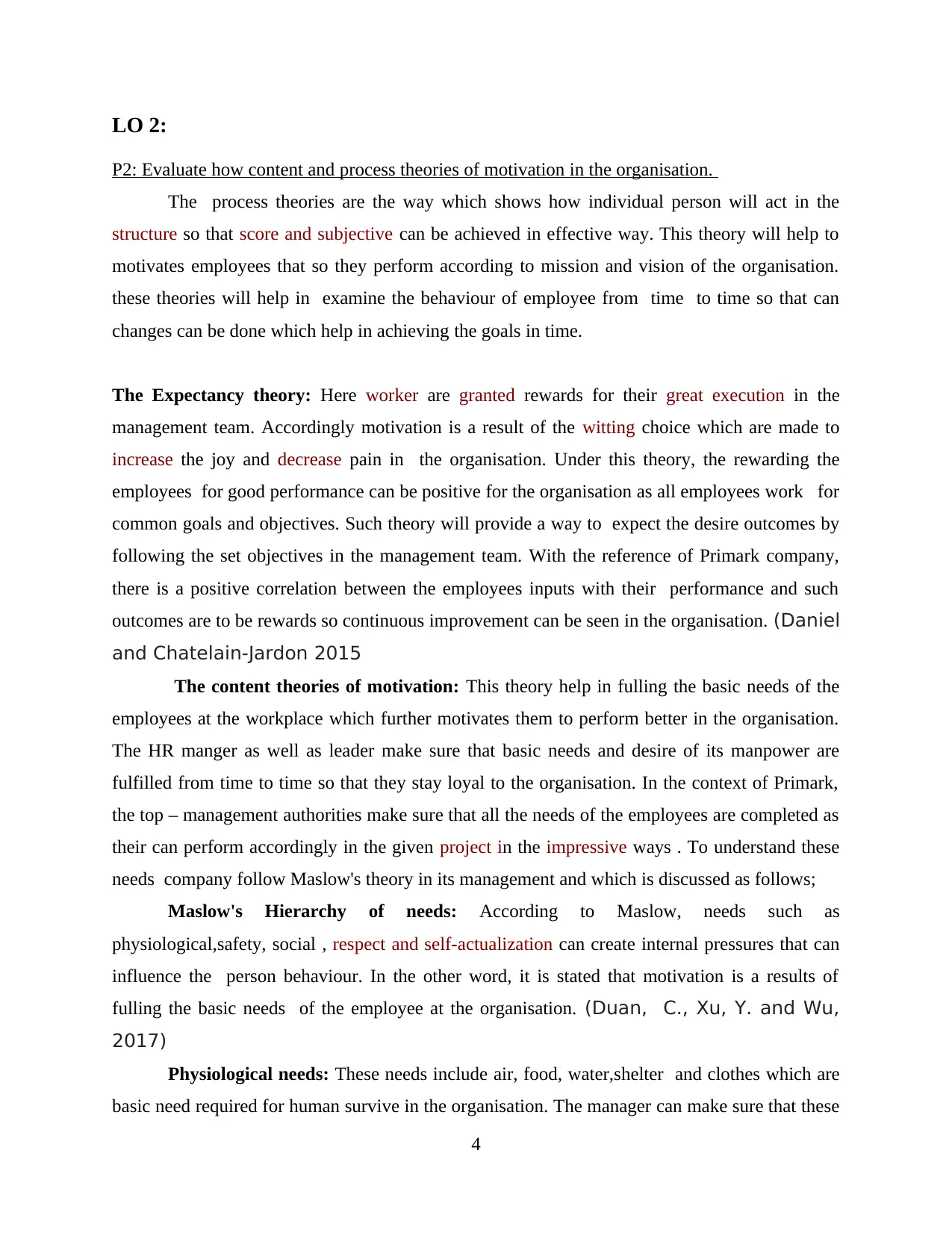
LO 2:
P2: Evaluate how content and process theories of motivation in the organisation.
The process theories are the way which shows how individual person will act in the
structure so that score and subjective can be achieved in effective way. This theory will help to
motivates employees that so they perform according to mission and vision of the organisation.
these theories will help in examine the behaviour of employee from time to time so that can
changes can be done which help in achieving the goals in time.
The Expectancy theory: Here worker are granted rewards for their great execution in the
management team. Accordingly motivation is a result of the witting choice which are made to
increase the joy and decrease pain in the organisation. Under this theory, the rewarding the
employees for good performance can be positive for the organisation as all employees work for
common goals and objectives. Such theory will provide a way to expect the desire outcomes by
following the set objectives in the management team. With the reference of Primark company,
there is a positive correlation between the employees inputs with their performance and such
outcomes are to be rewards so continuous improvement can be seen in the organisation. (Daniel
and Chatelain-Jardon 2015
The content theories of motivation: This theory help in fulling the basic needs of the
employees at the workplace which further motivates them to perform better in the organisation.
The HR manger as well as leader make sure that basic needs and desire of its manpower are
fulfilled from time to time so that they stay loyal to the organisation. In the context of Primark,
the top – management authorities make sure that all the needs of the employees are completed as
their can perform accordingly in the given project in the impressive ways . To understand these
needs company follow Maslow's theory in its management and which is discussed as follows;
Maslow's Hierarchy of needs: According to Maslow, needs such as
physiological,safety, social , respect and self-actualization can create internal pressures that can
influence the person behaviour. In the other word, it is stated that motivation is a results of
fulling the basic needs of the employee at the organisation. (Duan, C., Xu, Y. and Wu,
2017)
Physiological needs: These needs include air, food, water,shelter and clothes which are
basic need required for human survive in the organisation. The manager can make sure that these
4
P2: Evaluate how content and process theories of motivation in the organisation.
The process theories are the way which shows how individual person will act in the
structure so that score and subjective can be achieved in effective way. This theory will help to
motivates employees that so they perform according to mission and vision of the organisation.
these theories will help in examine the behaviour of employee from time to time so that can
changes can be done which help in achieving the goals in time.
The Expectancy theory: Here worker are granted rewards for their great execution in the
management team. Accordingly motivation is a result of the witting choice which are made to
increase the joy and decrease pain in the organisation. Under this theory, the rewarding the
employees for good performance can be positive for the organisation as all employees work for
common goals and objectives. Such theory will provide a way to expect the desire outcomes by
following the set objectives in the management team. With the reference of Primark company,
there is a positive correlation between the employees inputs with their performance and such
outcomes are to be rewards so continuous improvement can be seen in the organisation. (Daniel
and Chatelain-Jardon 2015
The content theories of motivation: This theory help in fulling the basic needs of the
employees at the workplace which further motivates them to perform better in the organisation.
The HR manger as well as leader make sure that basic needs and desire of its manpower are
fulfilled from time to time so that they stay loyal to the organisation. In the context of Primark,
the top – management authorities make sure that all the needs of the employees are completed as
their can perform accordingly in the given project in the impressive ways . To understand these
needs company follow Maslow's theory in its management and which is discussed as follows;
Maslow's Hierarchy of needs: According to Maslow, needs such as
physiological,safety, social , respect and self-actualization can create internal pressures that can
influence the person behaviour. In the other word, it is stated that motivation is a results of
fulling the basic needs of the employee at the organisation. (Duan, C., Xu, Y. and Wu,
2017)
Physiological needs: These needs include air, food, water,shelter and clothes which are
basic need required for human survive in the organisation. The manager can make sure that these
4
⊘ This is a preview!⊘
Do you want full access?
Subscribe today to unlock all pages.

Trusted by 1+ million students worldwide
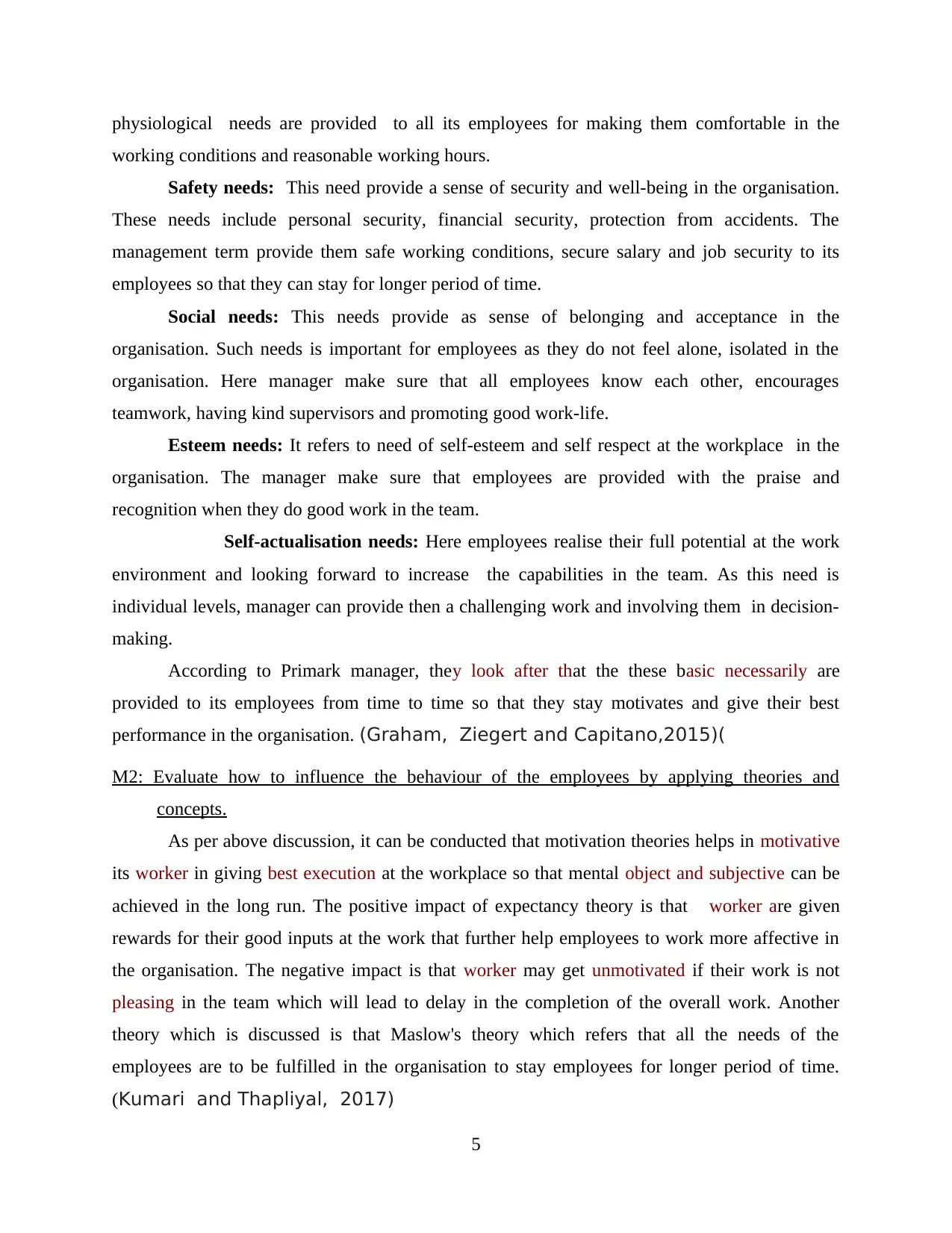
physiological needs are provided to all its employees for making them comfortable in the
working conditions and reasonable working hours.
Safety needs: This need provide a sense of security and well-being in the organisation.
These needs include personal security, financial security, protection from accidents. The
management term provide them safe working conditions, secure salary and job security to its
employees so that they can stay for longer period of time.
Social needs: This needs provide as sense of belonging and acceptance in the
organisation. Such needs is important for employees as they do not feel alone, isolated in the
organisation. Here manager make sure that all employees know each other, encourages
teamwork, having kind supervisors and promoting good work-life.
Esteem needs: It refers to need of self-esteem and self respect at the workplace in the
organisation. The manager make sure that employees are provided with the praise and
recognition when they do good work in the team.
Self-actualisation needs: Here employees realise their full potential at the work
environment and looking forward to increase the capabilities in the team. As this need is
individual levels, manager can provide then a challenging work and involving them in decision-
making.
According to Primark manager, they look after that the these basic necessarily are
provided to its employees from time to time so that they stay motivates and give their best
performance in the organisation. (Graham, Ziegert and Capitano,2015)(
M2: Evaluate how to influence the behaviour of the employees by applying theories and
concepts.
As per above discussion, it can be conducted that motivation theories helps in motivative
its worker in giving best execution at the workplace so that mental object and subjective can be
achieved in the long run. The positive impact of expectancy theory is that worker are given
rewards for their good inputs at the work that further help employees to work more affective in
the organisation. The negative impact is that worker may get unmotivated if their work is not
pleasing in the team which will lead to delay in the completion of the overall work. Another
theory which is discussed is that Maslow's theory which refers that all the needs of the
employees are to be fulfilled in the organisation to stay employees for longer period of time.
(Kumari and Thapliyal, 2017)
5
working conditions and reasonable working hours.
Safety needs: This need provide a sense of security and well-being in the organisation.
These needs include personal security, financial security, protection from accidents. The
management term provide them safe working conditions, secure salary and job security to its
employees so that they can stay for longer period of time.
Social needs: This needs provide as sense of belonging and acceptance in the
organisation. Such needs is important for employees as they do not feel alone, isolated in the
organisation. Here manager make sure that all employees know each other, encourages
teamwork, having kind supervisors and promoting good work-life.
Esteem needs: It refers to need of self-esteem and self respect at the workplace in the
organisation. The manager make sure that employees are provided with the praise and
recognition when they do good work in the team.
Self-actualisation needs: Here employees realise their full potential at the work
environment and looking forward to increase the capabilities in the team. As this need is
individual levels, manager can provide then a challenging work and involving them in decision-
making.
According to Primark manager, they look after that the these basic necessarily are
provided to its employees from time to time so that they stay motivates and give their best
performance in the organisation. (Graham, Ziegert and Capitano,2015)(
M2: Evaluate how to influence the behaviour of the employees by applying theories and
concepts.
As per above discussion, it can be conducted that motivation theories helps in motivative
its worker in giving best execution at the workplace so that mental object and subjective can be
achieved in the long run. The positive impact of expectancy theory is that worker are given
rewards for their good inputs at the work that further help employees to work more affective in
the organisation. The negative impact is that worker may get unmotivated if their work is not
pleasing in the team which will lead to delay in the completion of the overall work. Another
theory which is discussed is that Maslow's theory which refers that all the needs of the
employees are to be fulfilled in the organisation to stay employees for longer period of time.
(Kumari and Thapliyal, 2017)
5
Paraphrase This Document
Need a fresh take? Get an instant paraphrase of this document with our AI Paraphraser
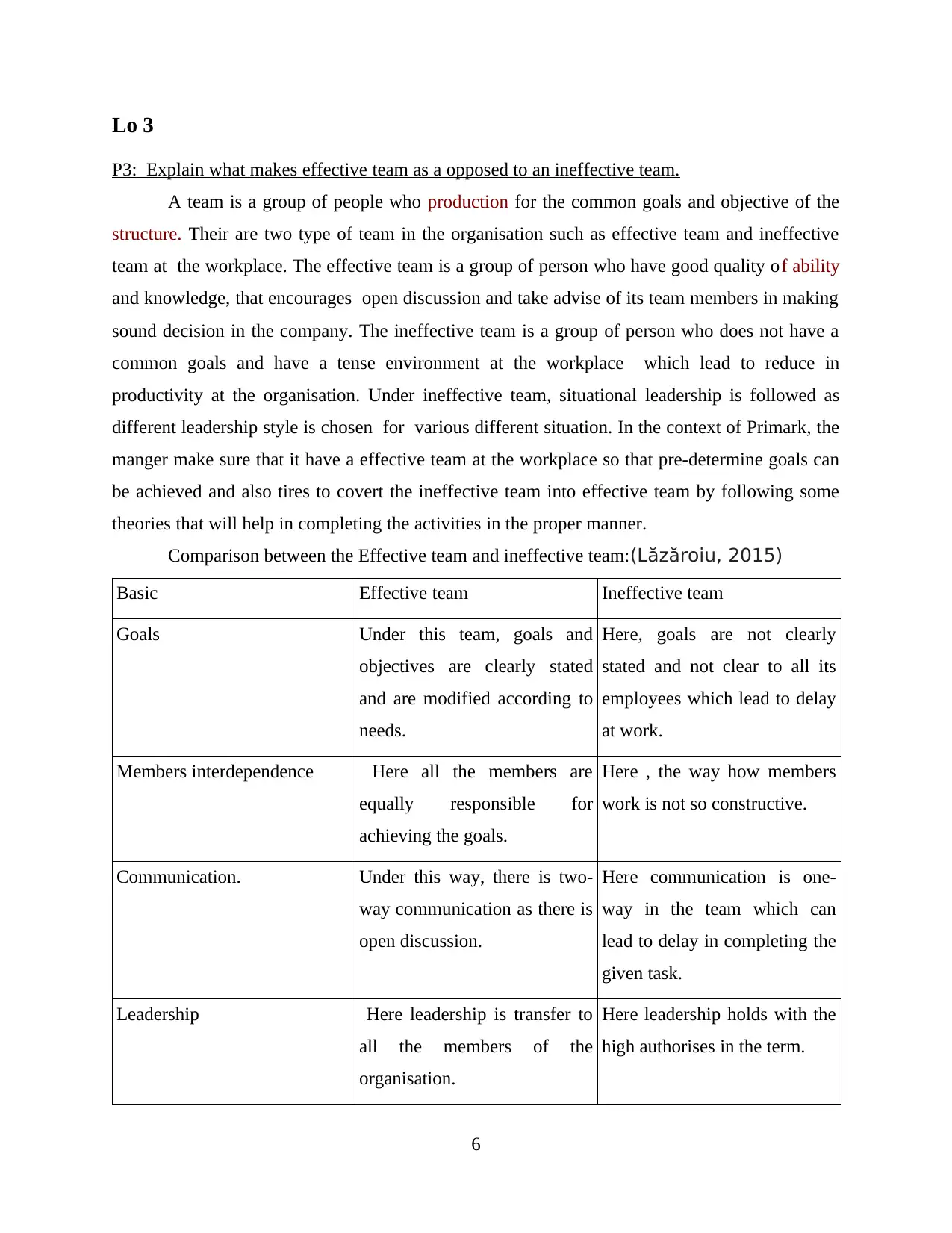
Lo 3
P3: Explain what makes effective team as a opposed to an ineffective team.
A team is a group of people who production for the common goals and objective of the
structure. Their are two type of team in the organisation such as effective team and ineffective
team at the workplace. The effective team is a group of person who have good quality of ability
and knowledge, that encourages open discussion and take advise of its team members in making
sound decision in the company. The ineffective team is a group of person who does not have a
common goals and have a tense environment at the workplace which lead to reduce in
productivity at the organisation. Under ineffective team, situational leadership is followed as
different leadership style is chosen for various different situation. In the context of Primark, the
manger make sure that it have a effective team at the workplace so that pre-determine goals can
be achieved and also tires to covert the ineffective team into effective team by following some
theories that will help in completing the activities in the proper manner.
Comparison between the Effective team and ineffective team:(Lăzăroiu, 2015)
Basic Effective team Ineffective team
Goals Under this team, goals and
objectives are clearly stated
and are modified according to
needs.
Here, goals are not clearly
stated and not clear to all its
employees which lead to delay
at work.
Members interdependence Here all the members are
equally responsible for
achieving the goals.
Here , the way how members
work is not so constructive.
Communication. Under this way, there is two-
way communication as there is
open discussion.
Here communication is one-
way in the team which can
lead to delay in completing the
given task.
Leadership Here leadership is transfer to
all the members of the
organisation.
Here leadership holds with the
high authorises in the term.
6
P3: Explain what makes effective team as a opposed to an ineffective team.
A team is a group of people who production for the common goals and objective of the
structure. Their are two type of team in the organisation such as effective team and ineffective
team at the workplace. The effective team is a group of person who have good quality of ability
and knowledge, that encourages open discussion and take advise of its team members in making
sound decision in the company. The ineffective team is a group of person who does not have a
common goals and have a tense environment at the workplace which lead to reduce in
productivity at the organisation. Under ineffective team, situational leadership is followed as
different leadership style is chosen for various different situation. In the context of Primark, the
manger make sure that it have a effective team at the workplace so that pre-determine goals can
be achieved and also tires to covert the ineffective team into effective team by following some
theories that will help in completing the activities in the proper manner.
Comparison between the Effective team and ineffective team:(Lăzăroiu, 2015)
Basic Effective team Ineffective team
Goals Under this team, goals and
objectives are clearly stated
and are modified according to
needs.
Here, goals are not clearly
stated and not clear to all its
employees which lead to delay
at work.
Members interdependence Here all the members are
equally responsible for
achieving the goals.
Here , the way how members
work is not so constructive.
Communication. Under this way, there is two-
way communication as there is
open discussion.
Here communication is one-
way in the team which can
lead to delay in completing the
given task.
Leadership Here leadership is transfer to
all the members of the
organisation.
Here leadership holds with the
high authorises in the term.
6
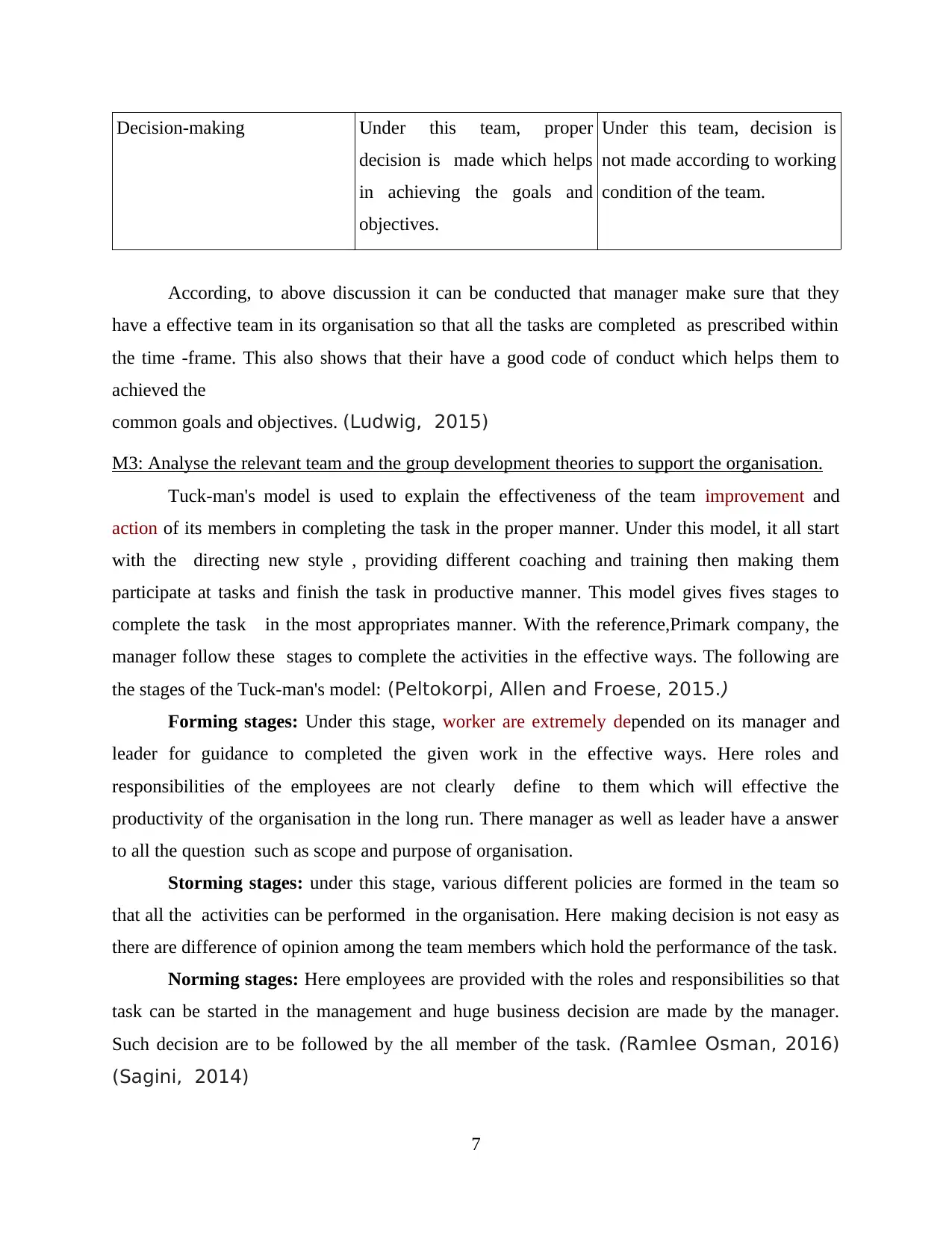
Decision-making Under this team, proper
decision is made which helps
in achieving the goals and
objectives.
Under this team, decision is
not made according to working
condition of the team.
According, to above discussion it can be conducted that manager make sure that they
have a effective team in its organisation so that all the tasks are completed as prescribed within
the time -frame. This also shows that their have a good code of conduct which helps them to
achieved the
common goals and objectives. (Ludwig, 2015)
M3: Analyse the relevant team and the group development theories to support the organisation.
Tuck-man's model is used to explain the effectiveness of the team improvement and
action of its members in completing the task in the proper manner. Under this model, it all start
with the directing new style , providing different coaching and training then making them
participate at tasks and finish the task in productive manner. This model gives fives stages to
complete the task in the most appropriates manner. With the reference,Primark company, the
manager follow these stages to complete the activities in the effective ways. The following are
the stages of the Tuck-man's model: (Peltokorpi, Allen and Froese, 2015.)
Forming stages: Under this stage, worker are extremely depended on its manager and
leader for guidance to completed the given work in the effective ways. Here roles and
responsibilities of the employees are not clearly define to them which will effective the
productivity of the organisation in the long run. There manager as well as leader have a answer
to all the question such as scope and purpose of organisation.
Storming stages: under this stage, various different policies are formed in the team so
that all the activities can be performed in the organisation. Here making decision is not easy as
there are difference of opinion among the team members which hold the performance of the task.
Norming stages: Here employees are provided with the roles and responsibilities so that
task can be started in the management and huge business decision are made by the manager.
Such decision are to be followed by the all member of the task. (Ramlee Osman, 2016)
(Sagini, 2014)
7
decision is made which helps
in achieving the goals and
objectives.
Under this team, decision is
not made according to working
condition of the team.
According, to above discussion it can be conducted that manager make sure that they
have a effective team in its organisation so that all the tasks are completed as prescribed within
the time -frame. This also shows that their have a good code of conduct which helps them to
achieved the
common goals and objectives. (Ludwig, 2015)
M3: Analyse the relevant team and the group development theories to support the organisation.
Tuck-man's model is used to explain the effectiveness of the team improvement and
action of its members in completing the task in the proper manner. Under this model, it all start
with the directing new style , providing different coaching and training then making them
participate at tasks and finish the task in productive manner. This model gives fives stages to
complete the task in the most appropriates manner. With the reference,Primark company, the
manager follow these stages to complete the activities in the effective ways. The following are
the stages of the Tuck-man's model: (Peltokorpi, Allen and Froese, 2015.)
Forming stages: Under this stage, worker are extremely depended on its manager and
leader for guidance to completed the given work in the effective ways. Here roles and
responsibilities of the employees are not clearly define to them which will effective the
productivity of the organisation in the long run. There manager as well as leader have a answer
to all the question such as scope and purpose of organisation.
Storming stages: under this stage, various different policies are formed in the team so
that all the activities can be performed in the organisation. Here making decision is not easy as
there are difference of opinion among the team members which hold the performance of the task.
Norming stages: Here employees are provided with the roles and responsibilities so that
task can be started in the management and huge business decision are made by the manager.
Such decision are to be followed by the all member of the task. (Ramlee Osman, 2016)
(Sagini, 2014)
7
⊘ This is a preview!⊘
Do you want full access?
Subscribe today to unlock all pages.

Trusted by 1+ million students worldwide
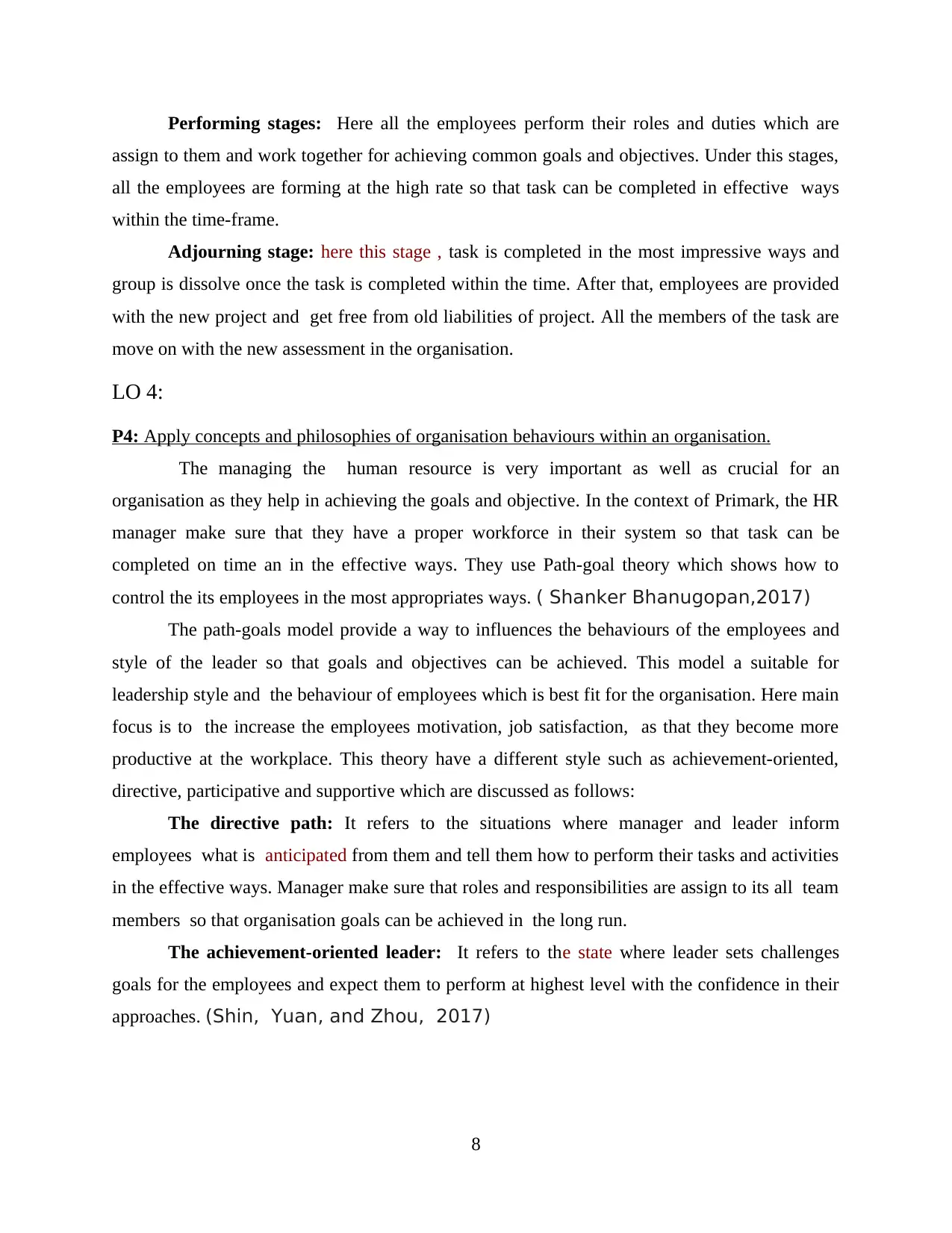
Performing stages: Here all the employees perform their roles and duties which are
assign to them and work together for achieving common goals and objectives. Under this stages,
all the employees are forming at the high rate so that task can be completed in effective ways
within the time-frame.
Adjourning stage: here this stage , task is completed in the most impressive ways and
group is dissolve once the task is completed within the time. After that, employees are provided
with the new project and get free from old liabilities of project. All the members of the task are
move on with the new assessment in the organisation.
LO 4:
P4: Apply concepts and philosophies of organisation behaviours within an organisation.
The managing the human resource is very important as well as crucial for an
organisation as they help in achieving the goals and objective. In the context of Primark, the HR
manager make sure that they have a proper workforce in their system so that task can be
completed on time an in the effective ways. They use Path-goal theory which shows how to
control the its employees in the most appropriates ways. ( Shanker Bhanugopan,2017)
The path-goals model provide a way to influences the behaviours of the employees and
style of the leader so that goals and objectives can be achieved. This model a suitable for
leadership style and the behaviour of employees which is best fit for the organisation. Here main
focus is to the increase the employees motivation, job satisfaction, as that they become more
productive at the workplace. This theory have a different style such as achievement-oriented,
directive, participative and supportive which are discussed as follows:
The directive path: It refers to the situations where manager and leader inform
employees what is anticipated from them and tell them how to perform their tasks and activities
in the effective ways. Manager make sure that roles and responsibilities are assign to its all team
members so that organisation goals can be achieved in the long run.
The achievement-oriented leader: It refers to the state where leader sets challenges
goals for the employees and expect them to perform at highest level with the confidence in their
approaches. (Shin, Yuan, and Zhou, 2017)
8
assign to them and work together for achieving common goals and objectives. Under this stages,
all the employees are forming at the high rate so that task can be completed in effective ways
within the time-frame.
Adjourning stage: here this stage , task is completed in the most impressive ways and
group is dissolve once the task is completed within the time. After that, employees are provided
with the new project and get free from old liabilities of project. All the members of the task are
move on with the new assessment in the organisation.
LO 4:
P4: Apply concepts and philosophies of organisation behaviours within an organisation.
The managing the human resource is very important as well as crucial for an
organisation as they help in achieving the goals and objective. In the context of Primark, the HR
manager make sure that they have a proper workforce in their system so that task can be
completed on time an in the effective ways. They use Path-goal theory which shows how to
control the its employees in the most appropriates ways. ( Shanker Bhanugopan,2017)
The path-goals model provide a way to influences the behaviours of the employees and
style of the leader so that goals and objectives can be achieved. This model a suitable for
leadership style and the behaviour of employees which is best fit for the organisation. Here main
focus is to the increase the employees motivation, job satisfaction, as that they become more
productive at the workplace. This theory have a different style such as achievement-oriented,
directive, participative and supportive which are discussed as follows:
The directive path: It refers to the situations where manager and leader inform
employees what is anticipated from them and tell them how to perform their tasks and activities
in the effective ways. Manager make sure that roles and responsibilities are assign to its all team
members so that organisation goals can be achieved in the long run.
The achievement-oriented leader: It refers to the state where leader sets challenges
goals for the employees and expect them to perform at highest level with the confidence in their
approaches. (Shin, Yuan, and Zhou, 2017)
8
Paraphrase This Document
Need a fresh take? Get an instant paraphrase of this document with our AI Paraphraser
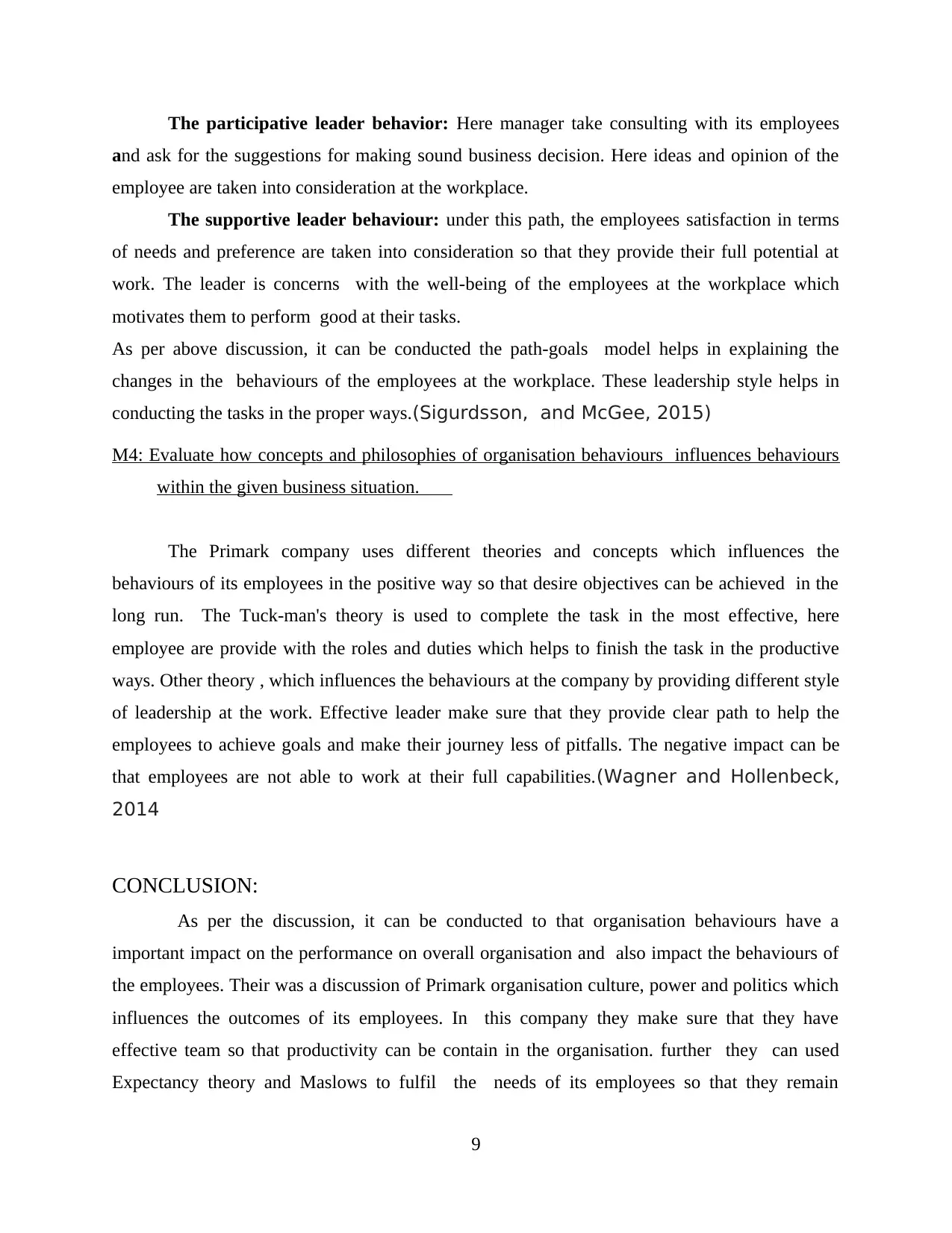
The participative leader behavior: Here manager take consulting with its employees
and ask for the suggestions for making sound business decision. Here ideas and opinion of the
employee are taken into consideration at the workplace.
The supportive leader behaviour: under this path, the employees satisfaction in terms
of needs and preference are taken into consideration so that they provide their full potential at
work. The leader is concerns with the well-being of the employees at the workplace which
motivates them to perform good at their tasks.
As per above discussion, it can be conducted the path-goals model helps in explaining the
changes in the behaviours of the employees at the workplace. These leadership style helps in
conducting the tasks in the proper ways.(Sigurdsson, and McGee, 2015)
M4: Evaluate how concepts and philosophies of organisation behaviours influences behaviours
within the given business situation.
The Primark company uses different theories and concepts which influences the
behaviours of its employees in the positive way so that desire objectives can be achieved in the
long run. The Tuck-man's theory is used to complete the task in the most effective, here
employee are provide with the roles and duties which helps to finish the task in the productive
ways. Other theory , which influences the behaviours at the company by providing different style
of leadership at the work. Effective leader make sure that they provide clear path to help the
employees to achieve goals and make their journey less of pitfalls. The negative impact can be
that employees are not able to work at their full capabilities.(Wagner and Hollenbeck,
2014
CONCLUSION:
As per the discussion, it can be conducted to that organisation behaviours have a
important impact on the performance on overall organisation and also impact the behaviours of
the employees. Their was a discussion of Primark organisation culture, power and politics which
influences the outcomes of its employees. In this company they make sure that they have
effective team so that productivity can be contain in the organisation. further they can used
Expectancy theory and Maslows to fulfil the needs of its employees so that they remain
9
and ask for the suggestions for making sound business decision. Here ideas and opinion of the
employee are taken into consideration at the workplace.
The supportive leader behaviour: under this path, the employees satisfaction in terms
of needs and preference are taken into consideration so that they provide their full potential at
work. The leader is concerns with the well-being of the employees at the workplace which
motivates them to perform good at their tasks.
As per above discussion, it can be conducted the path-goals model helps in explaining the
changes in the behaviours of the employees at the workplace. These leadership style helps in
conducting the tasks in the proper ways.(Sigurdsson, and McGee, 2015)
M4: Evaluate how concepts and philosophies of organisation behaviours influences behaviours
within the given business situation.
The Primark company uses different theories and concepts which influences the
behaviours of its employees in the positive way so that desire objectives can be achieved in the
long run. The Tuck-man's theory is used to complete the task in the most effective, here
employee are provide with the roles and duties which helps to finish the task in the productive
ways. Other theory , which influences the behaviours at the company by providing different style
of leadership at the work. Effective leader make sure that they provide clear path to help the
employees to achieve goals and make their journey less of pitfalls. The negative impact can be
that employees are not able to work at their full capabilities.(Wagner and Hollenbeck,
2014
CONCLUSION:
As per the discussion, it can be conducted to that organisation behaviours have a
important impact on the performance on overall organisation and also impact the behaviours of
the employees. Their was a discussion of Primark organisation culture, power and politics which
influences the outcomes of its employees. In this company they make sure that they have
effective team so that productivity can be contain in the organisation. further they can used
Expectancy theory and Maslows to fulfil the needs of its employees so that they remain
9
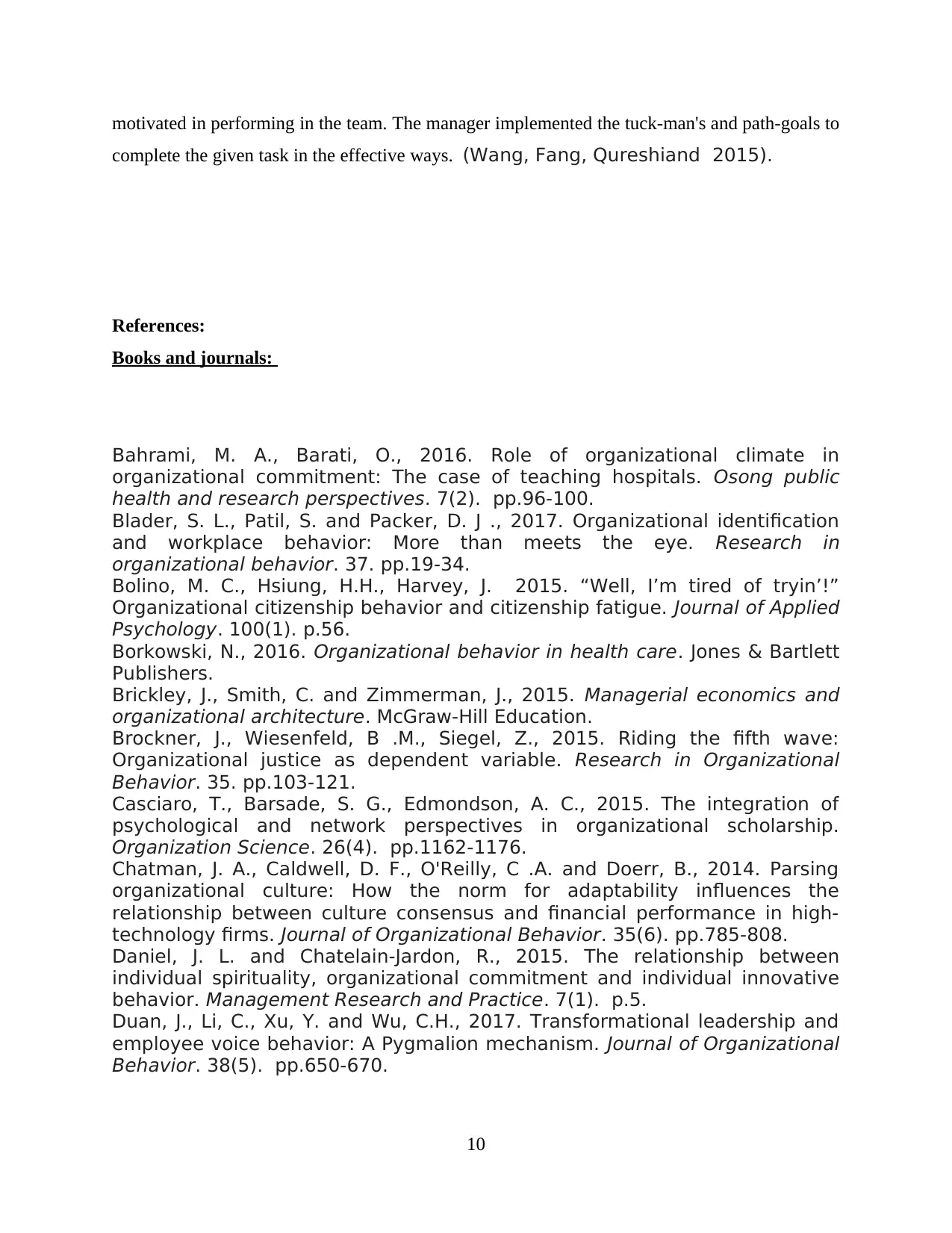
motivated in performing in the team. The manager implemented the tuck-man's and path-goals to
complete the given task in the effective ways. (Wang, Fang, Qureshiand 2015).
References:
Books and journals:
Bahrami, M. A., Barati, O., 2016. Role of organizational climate in
organizational commitment: The case of teaching hospitals. Osong public
health and research perspectives. 7(2). pp.96-100.
Blader, S. L., Patil, S. and Packer, D. J ., 2017. Organizational identification
and workplace behavior: More than meets the eye. Research in
organizational behavior. 37. pp.19-34.
Bolino, M. C., Hsiung, H.H., Harvey, J. 2015. “Well, I’m tired of tryin’!”
Organizational citizenship behavior and citizenship fatigue. Journal of Applied
Psychology. 100(1). p.56.
Borkowski, N., 2016. Organizational behavior in health care. Jones & Bartlett
Publishers.
Brickley, J., Smith, C. and Zimmerman, J., 2015. Managerial economics and
organizational architecture. McGraw-Hill Education.
Brockner, J., Wiesenfeld, B .M., Siegel, Z., 2015. Riding the fifth wave:
Organizational justice as dependent variable. Research in Organizational
Behavior. 35. pp.103-121.
Casciaro, T., Barsade, S. G., Edmondson, A. C., 2015. The integration of
psychological and network perspectives in organizational scholarship.
Organization Science. 26(4). pp.1162-1176.
Chatman, J. A., Caldwell, D. F., O'Reilly, C .A. and Doerr, B., 2014. Parsing
organizational culture: How the norm for adaptability influences the
relationship between culture consensus and financial performance in high‐
technology firms. Journal of Organizational Behavior. 35(6). pp.785-808.
Daniel, J. L. and Chatelain-Jardon, R., 2015. The relationship between
individual spirituality, organizational commitment and individual innovative
behavior. Management Research and Practice. 7(1). p.5.
Duan, J., Li, C., Xu, Y. and Wu, C.H., 2017. Transformational leadership and
employee voice behavior: A Pygmalion mechanism. Journal of Organizational
Behavior. 38(5). pp.650-670.
10
complete the given task in the effective ways. (Wang, Fang, Qureshiand 2015).
References:
Books and journals:
Bahrami, M. A., Barati, O., 2016. Role of organizational climate in
organizational commitment: The case of teaching hospitals. Osong public
health and research perspectives. 7(2). pp.96-100.
Blader, S. L., Patil, S. and Packer, D. J ., 2017. Organizational identification
and workplace behavior: More than meets the eye. Research in
organizational behavior. 37. pp.19-34.
Bolino, M. C., Hsiung, H.H., Harvey, J. 2015. “Well, I’m tired of tryin’!”
Organizational citizenship behavior and citizenship fatigue. Journal of Applied
Psychology. 100(1). p.56.
Borkowski, N., 2016. Organizational behavior in health care. Jones & Bartlett
Publishers.
Brickley, J., Smith, C. and Zimmerman, J., 2015. Managerial economics and
organizational architecture. McGraw-Hill Education.
Brockner, J., Wiesenfeld, B .M., Siegel, Z., 2015. Riding the fifth wave:
Organizational justice as dependent variable. Research in Organizational
Behavior. 35. pp.103-121.
Casciaro, T., Barsade, S. G., Edmondson, A. C., 2015. The integration of
psychological and network perspectives in organizational scholarship.
Organization Science. 26(4). pp.1162-1176.
Chatman, J. A., Caldwell, D. F., O'Reilly, C .A. and Doerr, B., 2014. Parsing
organizational culture: How the norm for adaptability influences the
relationship between culture consensus and financial performance in high‐
technology firms. Journal of Organizational Behavior. 35(6). pp.785-808.
Daniel, J. L. and Chatelain-Jardon, R., 2015. The relationship between
individual spirituality, organizational commitment and individual innovative
behavior. Management Research and Practice. 7(1). p.5.
Duan, J., Li, C., Xu, Y. and Wu, C.H., 2017. Transformational leadership and
employee voice behavior: A Pygmalion mechanism. Journal of Organizational
Behavior. 38(5). pp.650-670.
10
⊘ This is a preview!⊘
Do you want full access?
Subscribe today to unlock all pages.

Trusted by 1+ million students worldwide
1 out of 14
Related Documents
Your All-in-One AI-Powered Toolkit for Academic Success.
+13062052269
info@desklib.com
Available 24*7 on WhatsApp / Email
![[object Object]](/_next/static/media/star-bottom.7253800d.svg)
Unlock your academic potential
Copyright © 2020–2025 A2Z Services. All Rights Reserved. Developed and managed by ZUCOL.





